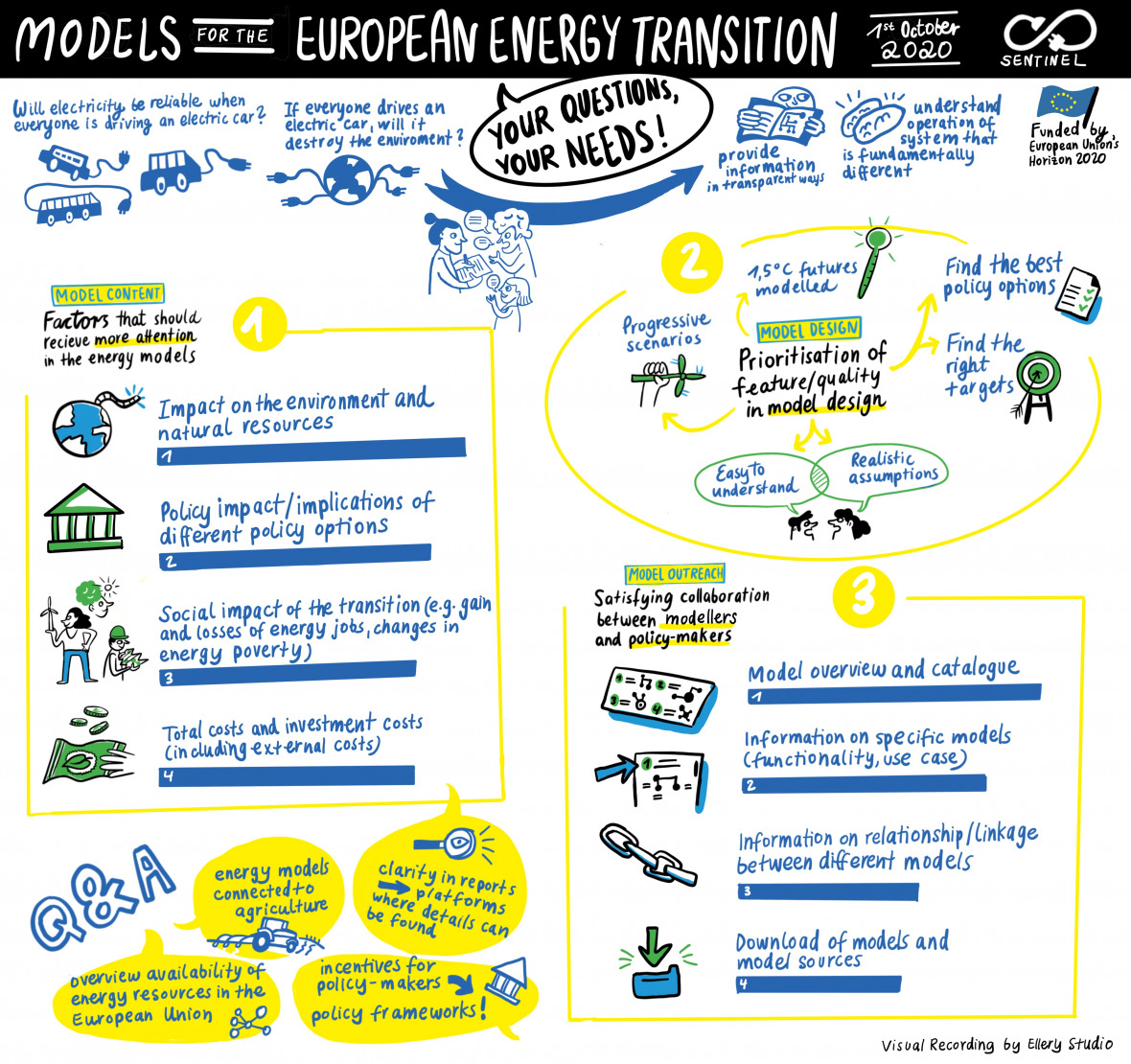Headline:
Modellers meet decision-makers: User needs for energy models for the European energy transition

The energy transition raises many questions about how to achieve and design net-zero emission energy systems. Energy models can support decision-makers by providing virtual laboratories in which different energy futures can be explored. But what are the requirements of different stakeholders on these energy models? Which challenges of the energy transition should they tackle? What questions should these models be able to answer? In order to identify needs and discuss the expectations placed on energy modelling in the framework of the project Sustainable Energy Transition Laboratory (SENTINEL), we conducted an online survey in summer and held an online expert workshop on the 1st of October.
What issues must energy models address? ─ Key results from our survey
In summer, we ran an online survey to identify the needs of different stakeholders using energy models. Ninety questionnaires were completed by representatives from policy-making, energy industry actors, grid operators, civil society, and the scientific community. We found that diverse environmental, social and political aspects of the energy transition are gaining increasing attention among decision-makers. Half of the respondents stated that impacts on environment and resource use as well as consumer behaviour und lifestyles should receive more attention in models, closely followed by an extended cost perception and new, progressive technologies (compare Fig. 1).
Fig. 1: Response to the question: Which of the following factors do you think should receive more attention in energy models? Multiple choice (up to 5 options), N=86, Survey August 2020 (c) SENTINEL. View as a PDF.
Models are needed that can better capture aspects such as the environmental impacts of technologies, social acceptance, or political preferences. As all these fields demand specific knowledge, inter- and transdisciplinary modelling involving diverse stakeholders from science and praxis is both necessary and highly appreciated. The majority of respondents (80%) from different stakeholder groups that wanted to contribute to the improvement of the modelling process viewed involvement in modelling as important (see figure 2). This finding reveals the demand for stakeholder-involving modelling, and we suggest that transdisciplinary approaches (as seen in the SENTINEL project) be incorporated in current and future modelling projects more systematically.
Fig. 2: Response to the question: How important is your involvement in conceptually developing or improving models for you? (Likert Score), N=29, Survey August 2020 (c) SENTINEL. View as a PDF.
This week, we are presenting these and further key results of the survey at the Energy Modelling Platform for Europe (EMP-E) conference.
Your Questions, your needs for energy models!? ─ Insights from our expert workshop
In early October, the IASS co-organised an online workshop, bringing together energy modellers and decision-makers from politics, business, the energy industry, and civil society. We discussed how energy modelling should be advanced in order to support decision-makers and help tackle critical energy system design challenges. A key objective was to interactively prioritise diverse demands and to discuss the options to include them in models.
In the plenary sessions, stakeholders got the chance to prioritise different factors that should receive more attention in energy models. The top four ranked aspects were: (1) impact on the environment and natural resources, (2) policy impact/implication of different policy options, (3) social impacts of the transition, as well as (4) total costs and investment costs. The result indicates that decision-makers are increasingly aware of and sensitive to non-technical and non-economic aspects. The stakeholders also expressed a need for modelling addressing progressive scenarios and a 1.5°C future. With respect to communication, stakeholders expressed high demand for model overviews and catalogues, specific information on models, as well as information on linkages between models, and the ability to download models and sources. The results were visually recorded by Ellery Studio (see Fig. 3).
The plenary session was followed by five parallel sessions addressing social, environmental, and economic aspects as well as supply and demand aspects of the energy transition. We hosted a session on the social and political aspects of the energy transition. Participants in this workshop called for the improved integration of the impacts of social issues on energy politics (e.g. social movements), the social acceptance of energy technologies and infrastructure, as well as consumer behaviour in energy models. At the IASS, we are developing the modelling tool QTDIAN with which we aim to better reflect social drivers and constraints as well as policy preferences in energy models in order to deliver more realistic and sustainable modelling results. Please get in touch with us if you want to know more about our work.

Fig. 3: Visual recording of user demands of the energy models, expert workshop, October 2020. View as a PDF.
The insights from the expert workshop and survey will be used to develop and improve the models of the Sustainable Energy Transition Laboratory (SENTINEL) and will inform the development of a future modelling platform by an interdisciplinary consortium funded through the European Union's Horizon 2020 research and innovation programme.
Are you using energy models? Then get in touch and tell us about what you want to see in future energy models to support decision-making!

Add new comment